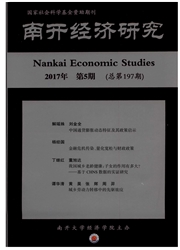

 中文摘要:
中文摘要:
本文将全要素生产率对经济增长的贡献率作为经济增长方式的衡量指标,对1995--2010年我国经济增长方式的变化特征进行了分析。在此基础上利用省际面板数据,分别从全国和地区两个层面考察了市场化进程与经济增长方式的关系。研究表明:我国经济增长方式的粗放型特征不仅没有出现弱化趋势,反而存在加重迹象。在全国层面上,我国市场化总进程对经济增长方式的转变具有促进作用,各市场化分项进程对经济增长方式转变的推进作用,按经济非国有化、产品市场发育、政府减少经济干预、要素市场发育和健全经济法律制度的顺序依次增强。在地区层面上,沿海和内陆地区市场化总进程均有助于经济增长方式的转变,其中沿海地区的驱动力度相对较强,各市场化分项进程与经济增长方式的作用关系在这两个地区有不同表现。上述结论对于进一步推进我国市场化改革以加快经济增长方式转型具有重要的启示意义。
 英文摘要:
英文摘要:
Taking the contribution of total factor productivity as the index of the economicgrowth pattern, this paper investigates characteristics of China's economic growth patternfrom 1995 to 2010. At the same time, based on provincial panel data, and using FMOLSestimator, the author analyzes the relationship between marketization and China's economicgrowth pattern. The results indicate that China's economic growth is still extensivegrowth. On the whole, marketization has positive effect on economic growth pattern inChina, The positive effect from the economic legal system reform is relatively strong-est. The positive effect on economic growth pattern incoastal and inland regions, Thepositive effect in coastal region is relatively stronger. The relationship between marketizationsubprocess and economic growth pattern is also different in coastal and inland regions.
 同期刊论文项目
同期刊论文项目
 同项目期刊论文
同项目期刊论文
 期刊信息
期刊信息
